CHEVROLET SILVERADO 2008 2.G Manual PDF
Manufacturer: CHEVROLET, Model Year: 2008, Model line: SILVERADO, Model: CHEVROLET SILVERADO 2008 2.GPages: 596, PDF Size: 3.12 MB
Page 71 of 596
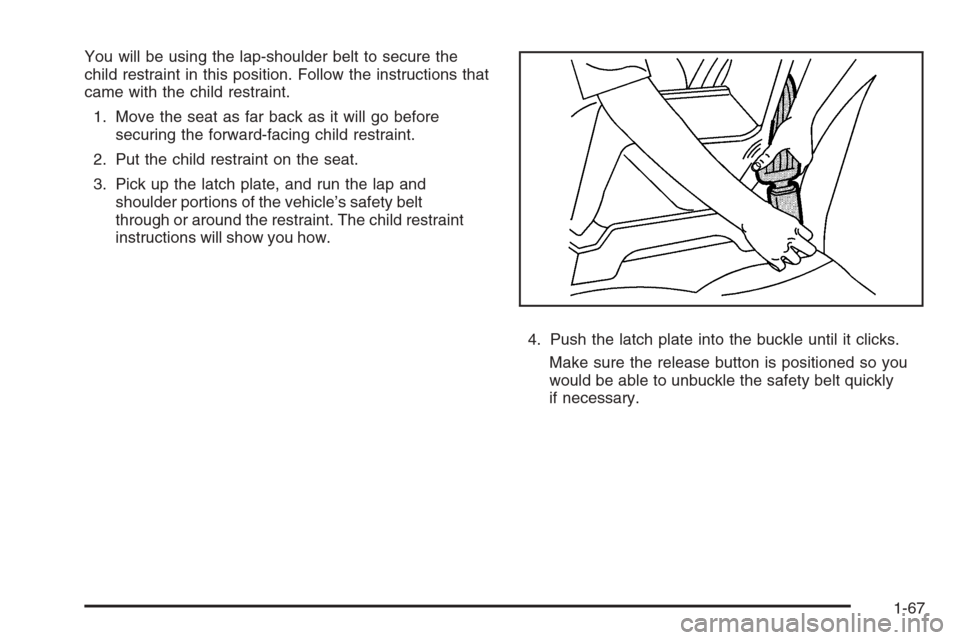
You will be using the lap-shoulder belt to secure the
child restraint in this position. Follow the instructions that
came with the child restraint.
1. Move the seat as far back as it will go before
securing the forward-facing child restraint.
2. Put the child restraint on the seat.
3. Pick up the latch plate, and run the lap and
shoulder portions of the vehicle’s safety belt
through or around the restraint. The child restraint
instructions will show you how.
4. Push the latch plate into the buckle until it clicks.
Make sure the release button is positioned so you
would be able to unbuckle the safety belt quickly
if necessary.
1-67
Page 72 of 596
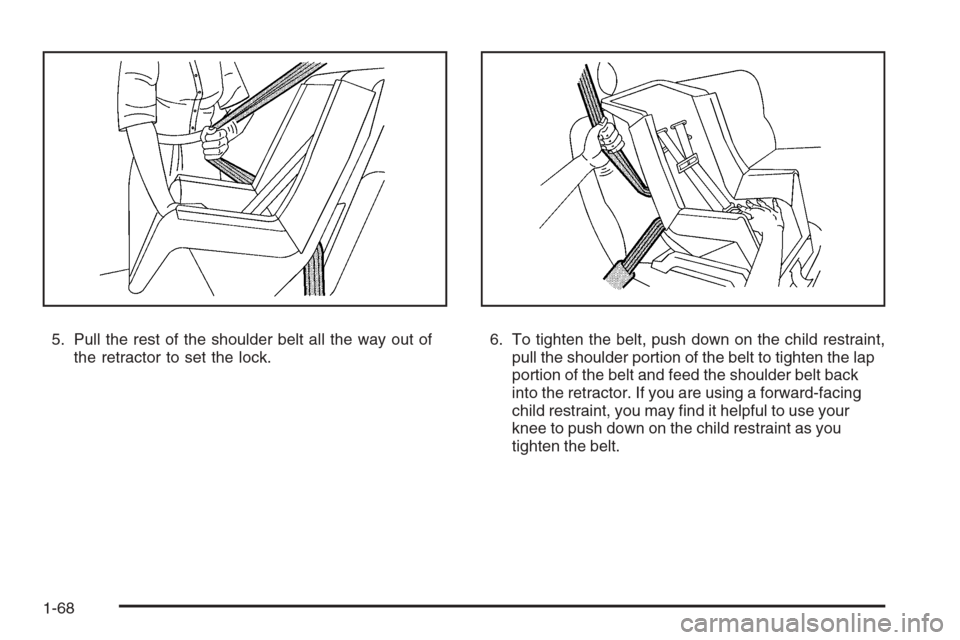
5. Pull the rest of the shoulder belt all the way out of
the retractor to set the lock.6. To tighten the belt, push down on the child restraint,
pull the shoulder portion of the belt to tighten the lap
portion of the belt and feed the shoulder belt back
into the retractor. If you are using a forward-facing
child restraint, you may �nd it helpful to use your
knee to push down on the child restraint as you
tighten the belt.
1-68
Page 73 of 596
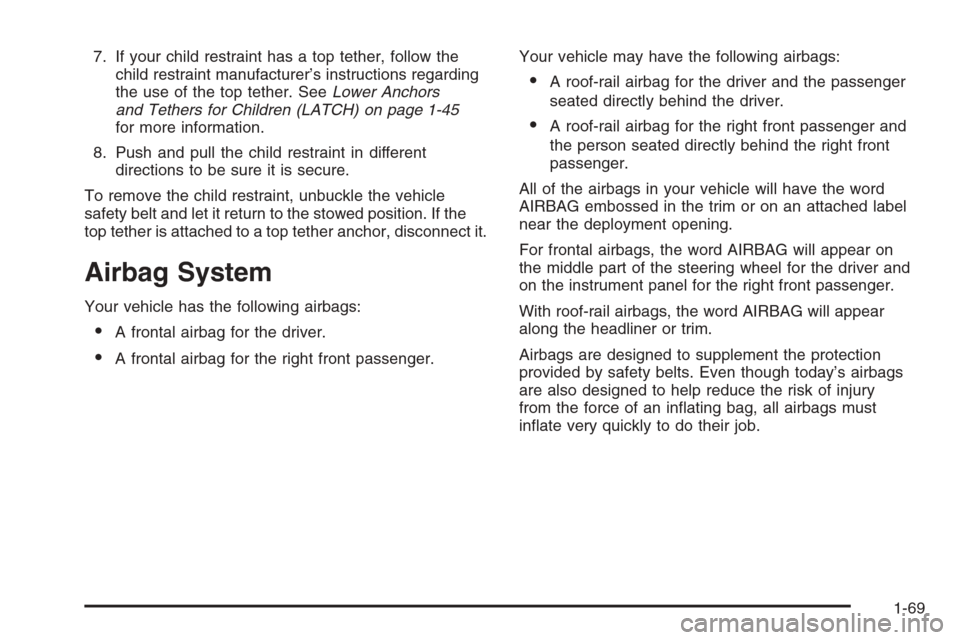
7. If your child restraint has a top tether, follow the
child restraint manufacturer’s instructions regarding
the use of the top tether. SeeLower Anchors
and Tethers for Children (LATCH) on page 1-45
for more information.
8. Push and pull the child restraint in different
directions to be sure it is secure.
To remove the child restraint, unbuckle the vehicle
safety belt and let it return to the stowed position. If the
top tether is attached to a top tether anchor, disconnect it.
Airbag System
Your vehicle has the following airbags:
A frontal airbag for the driver.
A frontal airbag for the right front passenger.Your vehicle may have the following airbags:
A roof-rail airbag for the driver and the passenger
seated directly behind the driver.
A roof-rail airbag for the right front passenger and
the person seated directly behind the right front
passenger.
All of the airbags in your vehicle will have the word
AIRBAG embossed in the trim or on an attached label
near the deployment opening.
For frontal airbags, the word AIRBAG will appear on
the middle part of the steering wheel for the driver and
on the instrument panel for the right front passenger.
With roof-rail airbags, the word AIRBAG will appear
along the headliner or trim.
Airbags are designed to supplement the protection
provided by safety belts. Even though today’s airbags
are also designed to help reduce the risk of injury
from the force of an in�ating bag, all airbags must
in�ate very quickly to do their job.
1-69
Page 74 of 596
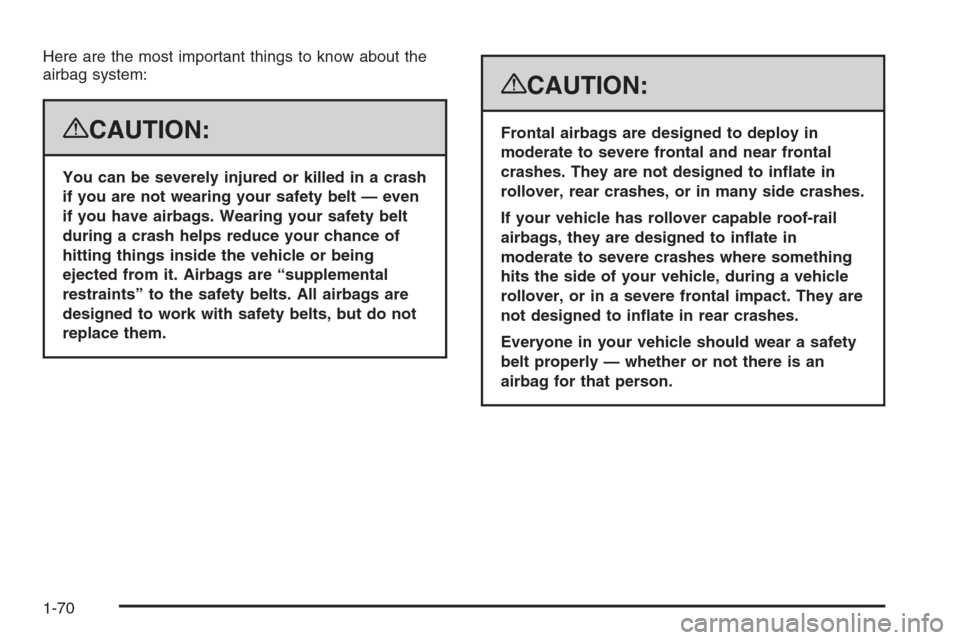
Here are the most important things to know about the
airbag system:
{CAUTION:
You can be severely injured or killed in a crash
if you are not wearing your safety belt — even
if you have airbags. Wearing your safety belt
during a crash helps reduce your chance of
hitting things inside the vehicle or being
ejected from it. Airbags are “supplemental
restraints” to the safety belts. All airbags are
designed to work with safety belts, but do not
replace them.
{CAUTION:
Frontal airbags are designed to deploy in
moderate to severe frontal and near frontal
crashes. They are not designed to in�ate in
rollover, rear crashes, or in many side crashes.
If your vehicle has rollover capable roof-rail
airbags, they are designed to in�ate in
moderate to severe crashes where something
hits the side of your vehicle, during a vehicle
rollover, or in a severe frontal impact. They are
not designed to in�ate in rear crashes.
Everyone in your vehicle should wear a safety
belt properly — whether or not there is an
airbag for that person.
1-70
Page 75 of 596
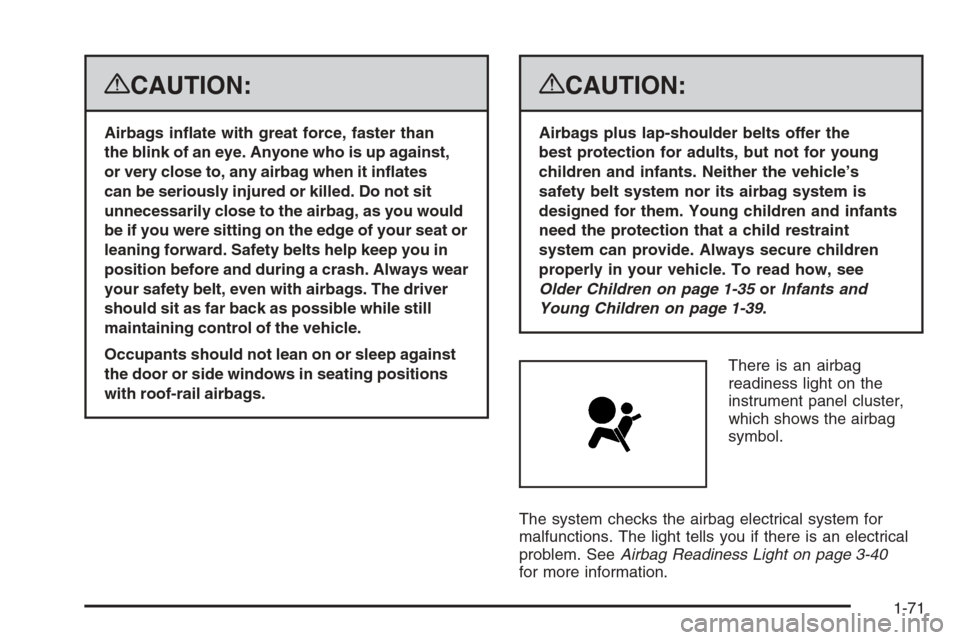
{CAUTION:
Airbags in�ate with great force, faster than
the blink of an eye. Anyone who is up against,
or very close to, any airbag when it in�ates
can be seriously injured or killed. Do not sit
unnecessarily close to the airbag, as you would
be if you were sitting on the edge of your seat or
leaning forward. Safety belts help keep you in
position before and during a crash. Always wear
your safety belt, even with airbags. The driver
should sit as far back as possible while still
maintaining control of the vehicle.
Occupants should not lean on or sleep against
the door or side windows in seating positions
with roof-rail airbags.
{CAUTION:
Airbags plus lap-shoulder belts offer the
best protection for adults, but not for young
children and infants. Neither the vehicle’s
safety belt system nor its airbag system is
designed for them. Young children and infants
need the protection that a child restraint
system can provide. Always secure children
properly in your vehicle. To read how, see
Older Children on page 1-35orInfants and
Young Children on page 1-39.
There is an airbag
readiness light on the
instrument panel cluster,
which shows the airbag
symbol.
The system checks the airbag electrical system for
malfunctions. The light tells you if there is an electrical
problem. SeeAirbag Readiness Light on page 3-40
for more information.
1-71
Page 76 of 596
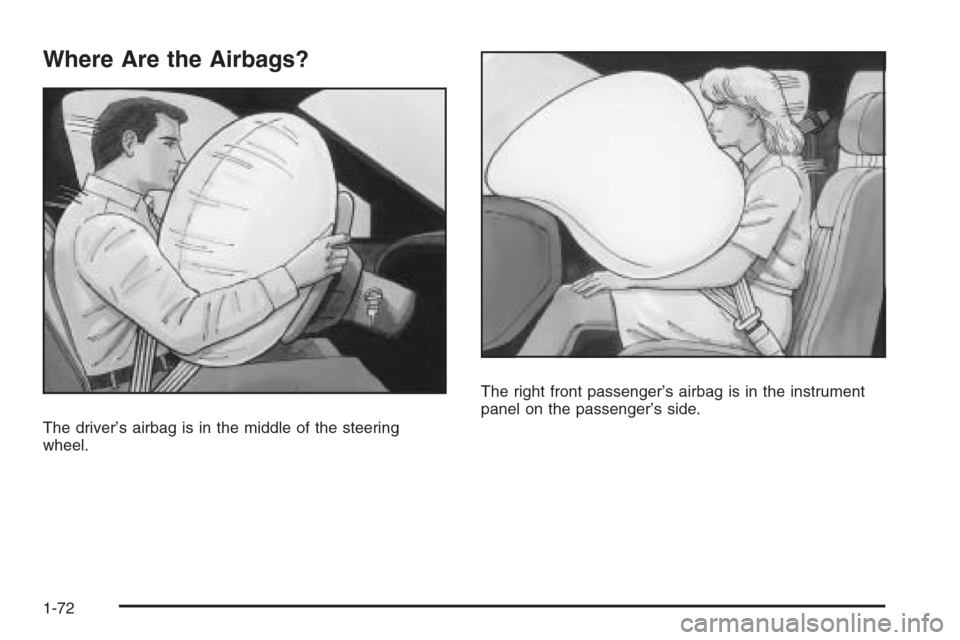
Where Are the Airbags?
The driver’s airbag is in the middle of the steering
wheel.The right front passenger’s airbag is in the instrument
panel on the passenger’s side.
1-72
Page 77 of 596
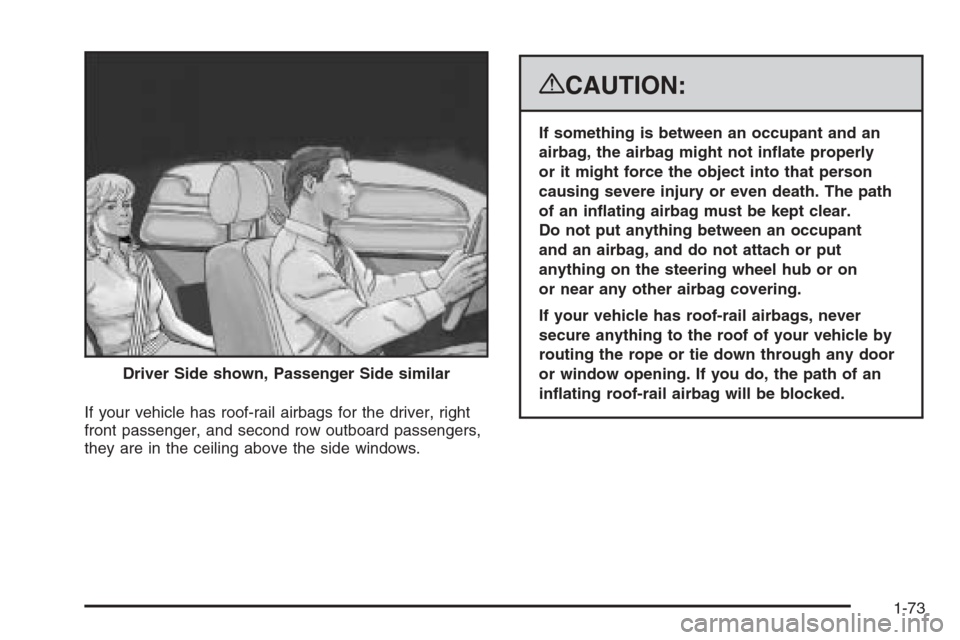
If your vehicle has roof-rail airbags for the driver, right
front passenger, and second row outboard passengers,
they are in the ceiling above the side windows.
{CAUTION:
If something is between an occupant and an
airbag, the airbag might not in�ate properly
or it might force the object into that person
causing severe injury or even death. The path
of an in�ating airbag must be kept clear.
Do not put anything between an occupant
and an airbag, and do not attach or put
anything on the steering wheel hub or on
or near any other airbag covering.
If your vehicle has roof-rail airbags, never
secure anything to the roof of your vehicle by
routing the rope or tie down through any door
or window opening. If you do, the path of an
in�ating roof-rail airbag will be blocked. Driver Side shown, Passenger Side similar
1-73
Page 78 of 596
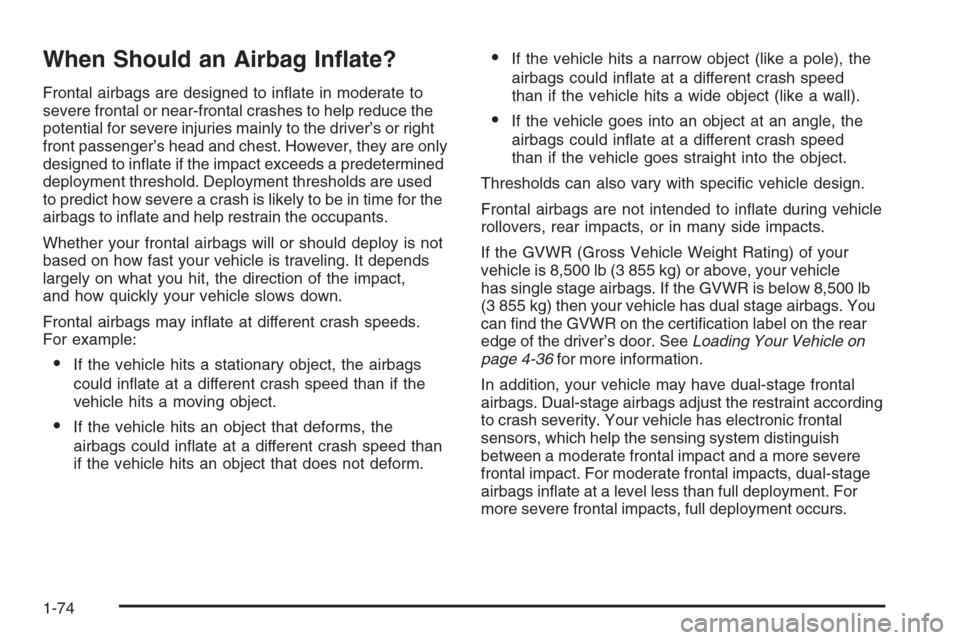
When Should an Airbag In�ate?
Frontal airbags are designed to in�ate in moderate to
severe frontal or near-frontal crashes to help reduce the
potential for severe injuries mainly to the driver’s or right
front passenger’s head and chest. However, they are only
designed to in�ate if the impact exceeds a predetermined
deployment threshold. Deployment thresholds are used
to predict how severe a crash is likely to be in time for the
airbags to in�ate and help restrain the occupants.
Whether your frontal airbags will or should deploy is not
based on how fast your vehicle is traveling. It depends
largely on what you hit, the direction of the impact,
and how quickly your vehicle slows down.
Frontal airbags may in�ate at different crash speeds.
For example:
If the vehicle hits a stationary object, the airbags
could in�ate at a different crash speed than if the
vehicle hits a moving object.
If the vehicle hits an object that deforms, the
airbags could in�ate at a different crash speed than
if the vehicle hits an object that does not deform.
If the vehicle hits a narrow object (like a pole), the
airbags could in�ate at a different crash speed
than if the vehicle hits a wide object (like a wall).
If the vehicle goes into an object at an angle, the
airbags could in�ate at a different crash speed
than if the vehicle goes straight into the object.
Thresholds can also vary with speci�c vehicle design.
Frontal airbags are not intended to in�ate during vehicle
rollovers, rear impacts, or in many side impacts.
If the GVWR (Gross Vehicle Weight Rating) of your
vehicle is 8,500 lb (3 855 kg) or above, your vehicle
has single stage airbags. If the GVWR is below 8,500 lb
(3 855 kg) then your vehicle has dual stage airbags. You
can �nd the GVWR on the certi�cation label on the rear
edge of the driver’s door. SeeLoading Your Vehicle on
page 4-36for more information.
In addition, your vehicle may have dual-stage frontal
airbags. Dual-stage airbags adjust the restraint according
to crash severity. Your vehicle has electronic frontal
sensors, which help the sensing system distinguish
between a moderate frontal impact and a more severe
frontal impact. For moderate frontal impacts, dual-stage
airbags in�ate at a level less than full deployment. For
more severe frontal impacts, full deployment occurs.
1-74
Page 79 of 596
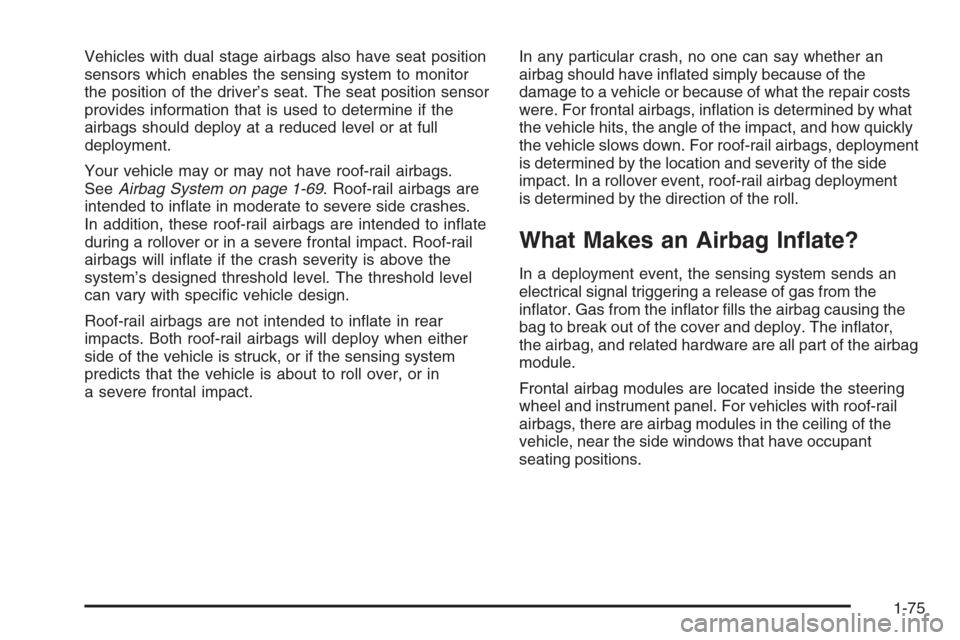
Vehicles with dual stage airbags also have seat position
sensors which enables the sensing system to monitor
the position of the driver’s seat. The seat position sensor
provides information that is used to determine if the
airbags should deploy at a reduced level or at full
deployment.
Your vehicle may or may not have roof-rail airbags.
SeeAirbag System on page 1-69. Roof-rail airbags are
intended to in�ate in moderate to severe side crashes.
In addition, these roof-rail airbags are intended to in�ate
during a rollover or in a severe frontal impact. Roof-rail
airbags will in�ate if the crash severity is above the
system’s designed threshold level. The threshold level
can vary with speci�c vehicle design.
Roof-rail airbags are not intended to in�ate in rear
impacts. Both roof-rail airbags will deploy when either
side of the vehicle is struck, or if the sensing system
predicts that the vehicle is about to roll over, or in
a severe frontal impact.In any particular crash, no one can say whether an
airbag should have in�ated simply because of the
damage to a vehicle or because of what the repair costs
were. For frontal airbags, in�ation is determined by what
the vehicle hits, the angle of the impact, and how quickly
the vehicle slows down. For roof-rail airbags, deployment
is determined by the location and severity of the side
impact. In a rollover event, roof-rail airbag deployment
is determined by the direction of the roll.
What Makes an Airbag In�ate?
In a deployment event, the sensing system sends an
electrical signal triggering a release of gas from the
in�ator. Gas from the in�ator �lls the airbag causing the
bag to break out of the cover and deploy. The in�ator,
the airbag, and related hardware are all part of the airbag
module.
Frontal airbag modules are located inside the steering
wheel and instrument panel. For vehicles with roof-rail
airbags, there are airbag modules in the ceiling of the
vehicle, near the side windows that have occupant
seating positions.
1-75
Page 80 of 596
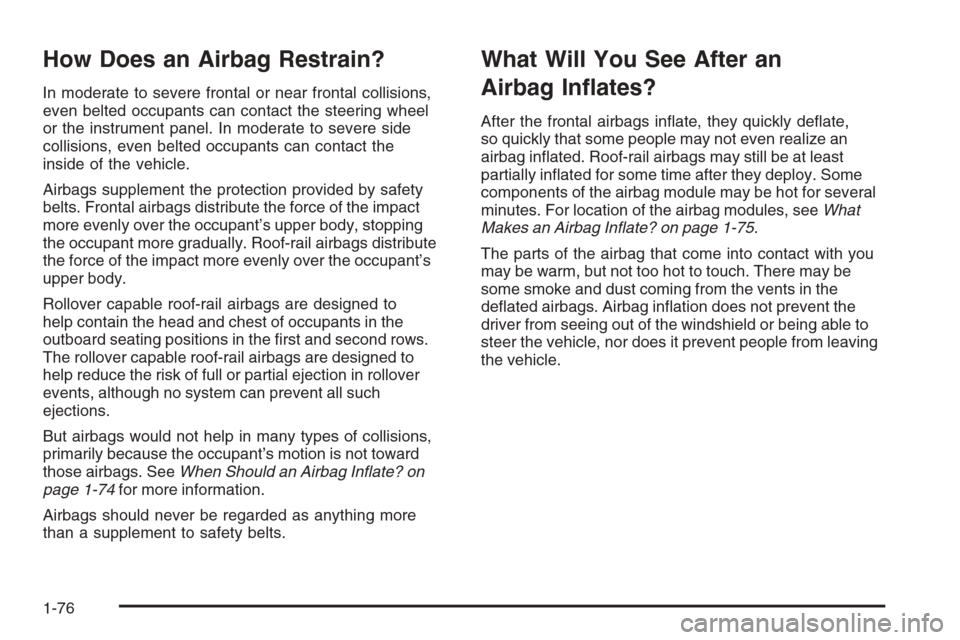
How Does an Airbag Restrain?
In moderate to severe frontal or near frontal collisions,
even belted occupants can contact the steering wheel
or the instrument panel. In moderate to severe side
collisions, even belted occupants can contact the
inside of the vehicle.
Airbags supplement the protection provided by safety
belts. Frontal airbags distribute the force of the impact
more evenly over the occupant’s upper body, stopping
the occupant more gradually. Roof-rail airbags distribute
the force of the impact more evenly over the occupant’s
upper body.
Rollover capable roof-rail airbags are designed to
help contain the head and chest of occupants in the
outboard seating positions in the �rst and second rows.
The rollover capable roof-rail airbags are designed to
help reduce the risk of full or partial ejection in rollover
events, although no system can prevent all such
ejections.
But airbags would not help in many types of collisions,
primarily because the occupant’s motion is not toward
those airbags. SeeWhen Should an Airbag Inflate? on
page 1-74for more information.
Airbags should never be regarded as anything more
than a supplement to safety belts.
What Will You See After an
Airbag In�ates?
After the frontal airbags in�ate, they quickly de�ate,
so quickly that some people may not even realize an
airbag in�ated. Roof-rail airbags may still be at least
partially in�ated for some time after they deploy. Some
components of the airbag module may be hot for several
minutes. For location of the airbag modules, seeWhat
Makes an Airbag Inflate? on page 1-75.
The parts of the airbag that come into contact with you
may be warm, but not too hot to touch. There may be
some smoke and dust coming from the vents in the
de�ated airbags. Airbag in�ation does not prevent the
driver from seeing out of the windshield or being able to
steer the vehicle, nor does it prevent people from leaving
the vehicle.
1-76